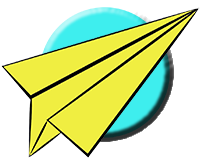Long Dart Elk Paper Airplane Plans
Long Dart Elk Paper Airplane Plans
Instructions
1. Fold the upper left corner down so the upper left point hits the right edge of the paper. When folded correctly, the top edge of the paper should line up with the right edge. Unfold after the crease has been made.
2. Fold the upper right corner down so the upper right point hits the left edge of the paper. When folded correctly, the top edge of the paper should line up with the left edge. Unfold after the crease has been made.
3. Flip the paper over so the diagonal creases are at the bottom .
4. Make a crease to fold the top edge of the paper down. The left and right points of the new horizontal crease should be where the diagonal creases hit the edges of the paper towards the top.
5. Rotate the paper around so the fold created in the previous step is to the right.
6. Fold the paper exactly in half about its long edge. Unfold after the crease has been made.
7. Rotate the paper around so the horizontal fold is at the top.
8. Fold the upper left corner down so the upper left point hits the bottom edge of the top-most flap. When folded correctly, the upper left edge should line up with the bottom edge of the horizontal flap. Unfold after the crease has been made.
9. Flip the paper over.
10. Make a crease to fold the upper right corner over. The bottom point of the new crease should be at the lower right corner of the paper should be at the upper left point of the small diagonal crease.
11. Pop the lower left point of the top-most flap up and bring it out. Bring the upper left point over and down hinged about two existing creases. As the fold is pressed flat a new diagonal crease is created along the left side.
12. Flip the paper over keeping the previously created flaps towards the top.
13. Fold the upper right corner down so the upper right point hits the bottom edge of the top-most flap. When folded correctly, the upper right edge should line up with the bottom edge of the horizontal flap. Unfold after the crease has been made.
14. Flip the paper over.
15. Make a crease to fold the upper left corner over. The bottom point of the new crease should be at the lower left corner of the paper and the top point should be at the upper right point of the small diagonal crease.
16. Pop the lower right point of the top-most flap up and bring it out. Bring the upper right point over and down hinged about two existing creases. As the fold is pressed flat a new diagonal crease is created along the right side.
17. Fold the lower right corner over so the lower right point hits the center line crease. When folded correctly, the right half of the bottom edge should line up with the center line crease.
18. Fold the point along the right side of the body in so it hits the center line crease. When folded correctly, the lower right diagonal edge should line up with the center line crease.
19. Pop the top-most layer of the front triangular flap up bringing the point at the lower left over and down. Two new creases are created as the fold is pressed flat.
20. Fold the small triangular flap over so the lower point hits the upper right diagonal edge.
21. Fold the lower left corner over so the lower point hits the center line crease. When folded correctly, the left half of the bottom edge should line up with the center line crease.
22. Fold the point along the left side of the body in so it hits the center line crease. When folded correctly, the lower left diagonal edge should line up with the center line crease.
23. Pop the top-most layer of the front triangular flap up bringing the point at the lower right over and down. Two new creases are created as the fold is pressed flat.
24. Fold the small triangular flap over so the lower point hits the upper left diagonal edge.
25. Fold the plane exactly in half about the center line crease. Be sure to line up the sides for good balance.
26. Make a crease to fold the wing tip flap down. The size of this flap is not too important but should be about one finger width wide
27. Flip the plane over so the first wing tip flap is underneath.
28. Make a crease to fold the second wing tip flap. Be sure to line up the wing tip flaps.
29. Make a crease for the first wing flap. The right point of the new crease should be just at the tip of the nose and the left point should be about two finger widths up from the bottom edge of the fuselage.
30. Flip the plane over and rotate it around so the first wing flap is underneath and the nose points to the left.
31. Make a crease for the second wing flap. Be sure to line up the wing flaps for good balance and flying characteristics.
32. Open the wing flaps and adjust the wing angles so they are even. Open up the wing tip flaps and adjust them so they extend beyond the main wing flaps. Set the dihedral flat or slightly up. Set the wing tip flaps so they are vertical when the plane relaxes in flight.
THE THROW Launch with a moderate level throw or at a slight up angle. Flights with this craft range from dives to stalls to flip-overs depending on the dihedral and the angle of the wing tip flaps. Experiment to find the best combination. A piece of tape to hold the fuselage together changes everything.
